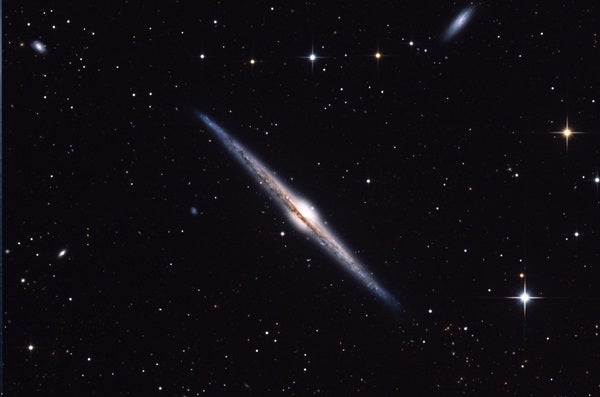Observers love looking at face-on spiral galaxies. There’s something captivating about seeing a disk of light with a concentrated core and magnificent sweeping arms containing millions of stars suspended in your eyepiece. But edge-on spirals offer an alternative view, and some observers enjoy them just as much. The finest example in the sky is the Needle Galaxy (NGC 4565), discovered by William Herschel in 1785.
NGC 4565 lies in the constellation Coma Berenices, 3° southeast of magnitude 4.3 Gamma (γ) Comae Berenices. It is the second brightest member of the Coma I Group, which contains some two dozen galaxies and may include up to 20 additional members. The center of this group lies approximately 47 million light-years away.
The Needle Galaxy glows at magnitude 9.6 and is easily visible through an 8-inch or larger scope. It’s not precisely edge-on because its plane inclines about 3.5° to our line of sight, but it’s close enough. Images show its length-to-width ratio is about 8-to-1, but visual limitations mean the object will appear five times longer than it is wide.
The center of the galaxy appears to be a small bulge. Recently, astronomers used the Spitzer Space Telescope to study the Needle at infrared wavelengths. They discovered that its central bulge is box shaped, meaning that its not actually a bulge, but a bar.
At high powers, you might detect the dust lane running along NGC 4565’s entire length. It’s easiest to pick out against the core. If you’re using at least a 14-inch scope, look ¼° west-southwest for one of the Needle’s companion galaxies, NGC 4562. At 14th magnitude, it’s a tough catch.
One final note of caution: If you’re star-hopping to this galaxy rather than using a go-to drive, don’t confuse the Needle Galaxy with the Silver Needle Galaxy (NGC 4244). That object lies 12.5° to the north-northwest and is in the constellation Canes Venatici the Hunting Dogs.
Make sure to explore Astronomy’s full list of 101 cosmic objects you must see. New entries will be added each week throughout 2022.










